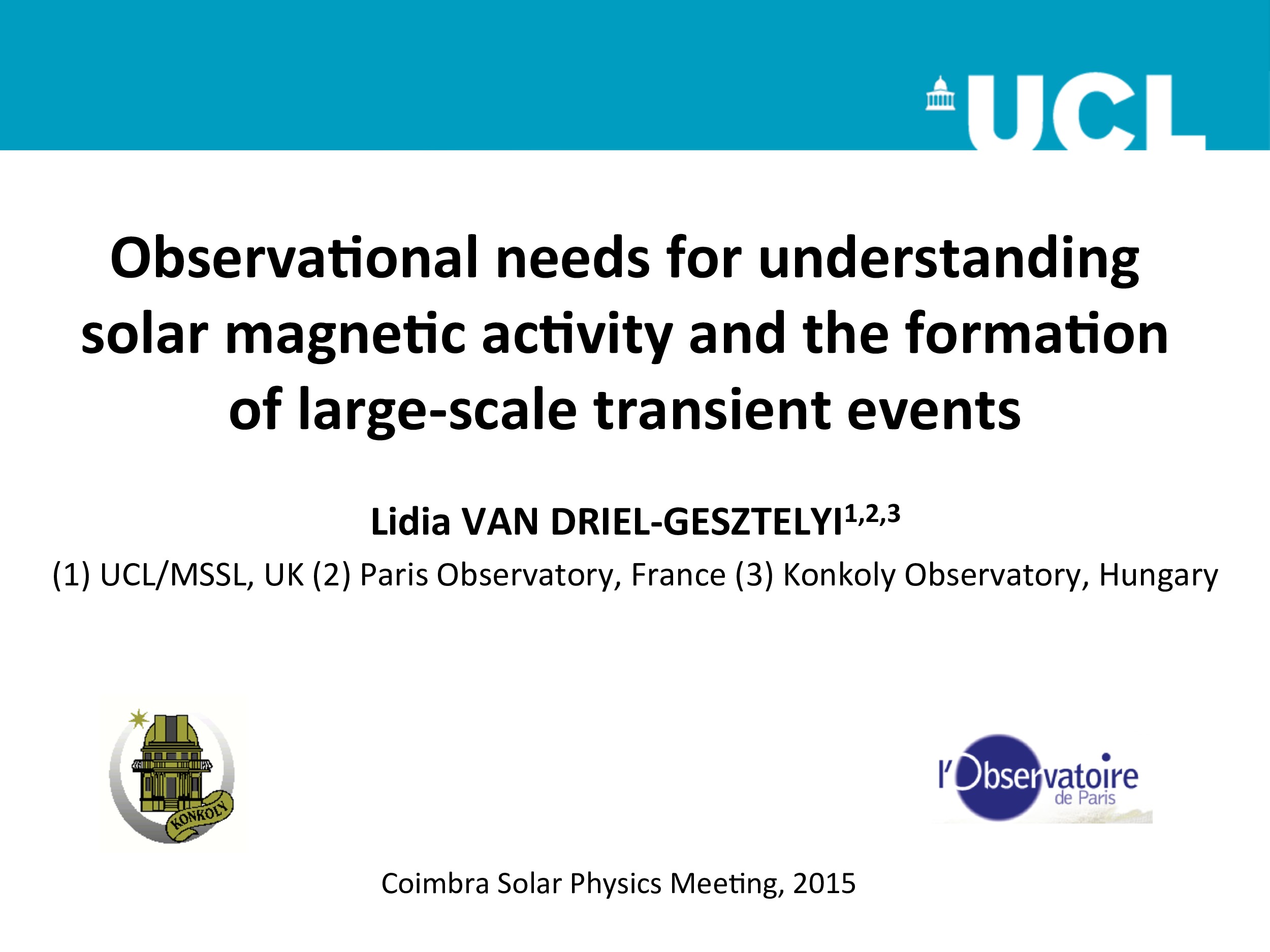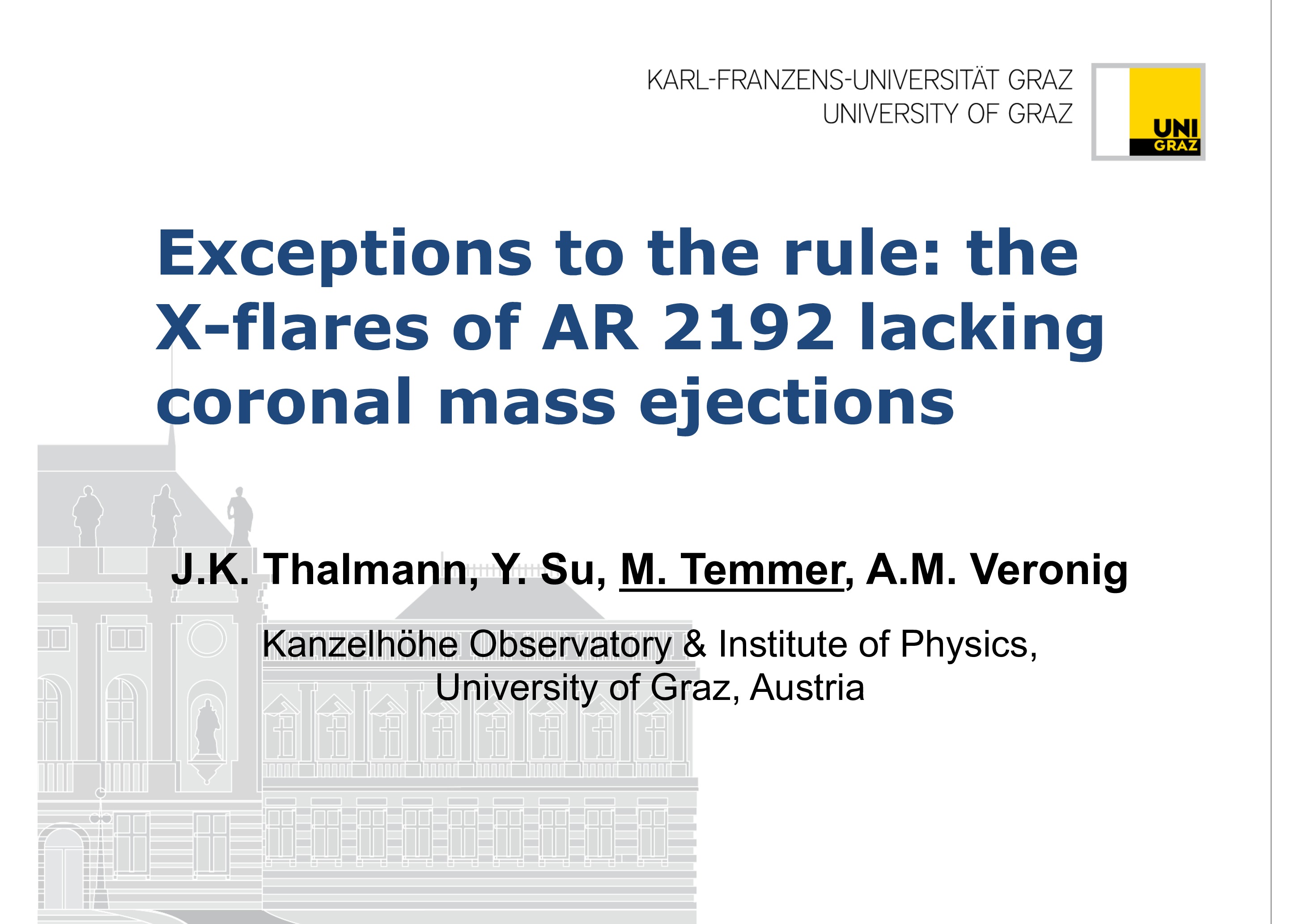
Geophysical and Astronomical Observatory, University of Coimbra (OGAUC)
Geo-Space Sciences Research Centre, University of Porto (CICGE, http://www.fc.up.pt/cicge/)
CENTRA - Instituto Superior Técnico, Univ. de Lisboa, Portugal, (http://centra.tecnico.ulisboa.pt)
Slovak Central Observatory, Hurbanovo, Slovakia (SCO, http://www.suh.sk)
Full-disk spectroheliograms have been routinely taken in Coimbra since 1926 in the Ca II K-line (K1 and K3) and in 1990 regular observations in the Hα line have also started. In 2006, the Astronomical Observatory of the University of Coimbra (Coimbra, Portugal) – Observatório Astronómico da Universidade de Coimbra (OAUC) organized an international solar physics meeting (the first Coimbra Solar Physics Meeting 2006) jointly with a historical session commemorating the life and work of Prof. Francisco Costa Lobo (1864-1945) who installed the spectroheliograph in Coimbra in the 1920s. On June 22, 2013, UNESCO added the University of Coimbra one of the oldest European universities founded in 1290, to its World Heritage List.
Now, we invite again a wide scientific community to join us in 2015, this time for discussing the state-of-art of solar ground-based and space-based observing techniques and related topics. This meeting is included in the celebration of the 150 years of Geophysical Institute of the University of Coimbra. It will take place in the University campus just inside the Coimbra historical down-town and will also include an excursion to the Coimbra Observatory which is located at the city periphery.
The Sun and its activity affect the entire heliosphere, including the Earth. Solar activity includes flares, coronal mass ejections (CMEs), eruptive prominences and filaments, outbursts at various spatial scales, sunspots, and plages. All these phenomena are driven by the magnetic field. Although these phenomena appear at time scales from seconds to months, the long-term variation of the magnetic field during the 11-year solar cycle modulates their frequency and space weather impact. Coronal phenomena are driven by the dynamo-generated fields that show large-scale organization.
Solar magnetic fields can be investigated from ground and space. Ground based observations of solar magnetic fields using polarimetry has a long history, contributing to the understanding of long-term behaviour of the Sun. Spectropolarimetric observations in FUV and EUV lines can only be made from space; they represent virgin territory and they are urgently needed for exploring the magnetic activity of the upper chromosphere and transition region.
This CSPM-2015 scientific meeting will cover various aspects of solar dynamic and magnetic phenomena which are observed over the entire electromagnetic spectrum: white-light, Hα, Ca II, and radio from ground and in a variety of other wavelengths (white light, UV and EUV, and X-rays) from space. Emphasis will also be placed on instrumentation, observing techniques, and solar image processing techniques, as well as theory and modelling through detailed radiative transfer in increasingly realistic MHD models. The long-term (cyclic) evolution of solar magnetism and its consequence for the solar atmosphere, eruptive phenomena, solar irradiation variations, and space weather, will be in focus. Here, special attention will be devoted to the long-term observations made in Coimbra and also to the results of the SPRING / SOLARNET and SCOSTEP VarSITI studies. In particular, the weak solar activity during the current solar maximum will be discussed. Finally, since this meeting is organised around the 90th anniversary of performing the first spectroheliographic observations in Coimbra, a session will be specially dedicated to new solar instruments (both ground-based and space-borne) that will give access to unexplored solar atmospheric features and dynamic phenomena over the coming years.
T. Barata (OGAUC/CITEUC, Coimbra, Portugal)
S. Carvalho (OGAUC/CITEUC, Coimbra, Portugal)
I. Dorotovič (OGAUC/CITEUC, Coimbra; UNINOVA-CA3, Caparica, Portugal; SCO, Hurbanovo, Slovakia)
T. Esperança (OGAUC, Coimbra, Portugal)
J. Fernandes (OGAUC/CITEUC, Coimbra, Portugal) - Chair
A. Garcia (OGAUC, Coimbra, Portugal)
D. Maia (CICGE, University of Porto, Portugal)
A. Morozova (OGAUC/CITEUC, Coimbra, Portugal)
D. Passos (CENTRA - Instituto Superior Técnico, Univ. de Lisboa, Portugal; GRPS, Univ. Montreal, Canada)
J. Aboudarham (OBSPM, Paris-Meudon, France)
F. Clette (ROB, Brussels, Belgium)
I. Dorotovič (OGAUC/CITEUC, Coimbra; UNINOVA-CA3, Caparica, Portugal; SCO, Hurbanovo, Slovakia) - Chair
C. Fischer (KIS, Freiburg, Germany)
L. Fletcher (University of Glasgow, Glasgow, Scotland, United Kingdom)
N. Gopalswamy (NASA-GSFC, Greenbelt, USA)
A. Kučera (AI SAS, Tatranská Lomnica, Slovakia) - Co-chair
D. Maia (CICGE, University of Porto, Portugal)
M. Sobotka (AI ASCR, Ondrejov, Czech Republic)
Y. Suematsu (NAOJ, Tokyo, Japan)
M. Temmer (IGAM, University of Graz, Austria)
J. Trujillo-Bueno (Instituto de Astrofísica de Canarias, La Laguna, Tenerife, Spain)
G. Tsiropoula (National Observatory of Athens, Athens, Greece)
B. Vršnak (Hvar Observatory, Zagreb, Croatia)
LIST OF INVITED SPEAKERS
• Session 1:
• L. van Driel-Gesztelyi (Mullard Space Science Laboratory, University College London, UK; LESIA, Paris Observatory, Paris-Meudon, France)
• K. Tziotziou (Institute for Astronomy, Astrophysics, Space Applications and Remote Sensing, National Observatory of Athens, Penteli, Greece)
• A. Pevtsov (National Solar Observatory/Sacramento Peak, Sunspot, USA)
• L. Bellot Rubio (Instituto de Astrofísica de Andalucía - CSIC, Granada, Spain)
• C. Denker (Leibniz Institute for Astrophysics (AIP), Potsdam, Germany)
• A. Lagg (Max Planck Institute for Solar System Research, Göttingen, Germany)
• Session 2:
• M. Löfdahl (Institute for Solar Physics, Stockholm University, Stockholm, Sweden)
• J. Ireland (ADNET Systems, Inc. / NASA-GSFC, Greenbelt, USA)
• M. van Noort (Max Planck Institute for Solar System Research, Göttingen, Germany)
• Session 3:
• T. Török (Predictive Science Inc., San Diego, USA)
• J. Leenaarts (Institute for Solar Physics, Stockholm University, Stockholm, Sweden)
• R. Erdélyi (Solar Physics & Space Plasma Reserach Centre (SP2RC), School of Mathematics & Statistics, University of Sheffield, UK)
• Session 4:
• A. Veronig (Kanzelhöhe Observatory/Institute of Physics, University of Graz, Austria)
• S. Solanki (Max Planck Institute for Solar System Research, Göttingen, Germany)
• I. Usoskin (Sodankylä Geophysical Observatory, University of Oulu, Finland)
• L. Bertello (National Solar Observatory, USA)
• Session 5:
• W. Schmidt (Kiepenheuer Institute for Solar Physics, Freiburg, Germany)
• M. Collados (Instituto de Astrofísica de Canarias, La Laguna, Tenerife, Spain)
• D. Müller (ESA-ESTEC, Noordwijk, The Netherlands)
• Y. Suematsu (National Astronomical Observatory of Japan, Tokyo, Japan)
• Y. Deng (National Astronomical Observatories, Chinese Academy of Sciences, Beijing, China)
15 November 2014 - First Announcement, web-site opens
- Registration, hotel reservation, and abstract submission opens
30 April 2015 - Closing date for abstract submission I. (for those who are going to apply for financial support)
- Closing date for financial support applications
20 June 2015 - Closing date for abstract submission II. (for those who do not apply for financial support)
- Closing date for Thomas Metcalf SPD Travel Award applications
- Information on financial supports
5 July 2015 - Information on accepted abstracts
- Second Announcement (Programme Finalised)
15 July 2015 - Closing date for early bird registration
15 September 2015 - Closing date for late registration and for hotel reservation
- Final Announcement
4 October 2015 - Arrival, registration
5 October 2015 - Meeting starts
9 October 2015 - Meeting ends
30 November 2015 - Submission deadline for proceedings manuscripts
The registration fee is 285 € per participant for early bird registration (till 15 July, 2015)
and 350 € per participant for late registration (till 15 September, 2015).
The registration fee for onsite registration and/or payment is also 350 €.
The LOC have a special agreement with the local professional congress organiser Abreu PCO to provide registration service, hotel reservation and social events arrangements. Special hotel rates have been negotiated for the participants of the meeting in several hotels.
If you are already registered and want to do any correction to your registration, please contact:
Helena Desidério
Abreu - PCO
Av. 25 de Abril 2 - Edifício Abreu
2799-556 Linda-a-Velha - Portugal
Congress Department
Fax: + 351 21 415 63 83
E-mail: helena.desiderio@abreu.pt
Coimbra is an old university town situated in the central region of Portugal, between Lisbon (200 km) and Porto (100 km) and about 35 km from the Atlantic coast at Figueira da Foz. It is easily reached from Lisbon and Porto, which both have international airports, by train (up to 2h from Lisbon and 1h15 from Porto) or by bus. The A1 motorway from Lisbon to Porto passes close to Coimbra; there are also good road connections with Spain through Salamanca.
Visit http://www.mat.uc.pt/~cspm2015/location.html for more information.

Session: Observations of the Sun (quiet and active Sun, magnetic fields, high-resolution (polarimetric) observations and transient phenomena from the photosphere to the chromosphere and corona)


Session: Long-term variations of the Sun (long-term (cyclic) evolution of solar magnetism and its consequence for the solar atmosphere, eruptive phenomena, solar irradiation variations, and space weather)

Session: Observations of the Sun (quiet and active Sun, magnetic fields, high-resolution (polarimetric) observations and transient phenomena from the photosphere to the chromosphere and corona)

Session: Theory and modeling - comparison to observations (constraints from observations)


Session: Long-term variations of the Sun (long-term (cyclic) evolution of solar magnetism and its consequence for the solar atmosphere, eruptive phenomena, solar irradiation variations, and space weather)

Session: Long-term variations of the Sun (long-term (cyclic) evolution of solar magnetism and its consequence for the solar atmosphere, eruptive phenomena, solar irradiation variations, and space weather)

Session: Observations of the Sun (quiet and active Sun, magnetic fields, high-resolution (polarimetric) observations and transient phenomena from the photosphere to the chromosphere and corona)

Session: Solar image management, spectro-polarimetric and processing techniques (overview of image management and processing techniques including tutorials)

Session: Theory and modeling - comparison to observations (constraints from observations)

Session: Observations of the Sun (quiet and active Sun, magnetic fields, high-resolution (polarimetric) observations and transient phenomena from the photosphere to the chromosphere and corona)

Session: Observations of the Sun (quiet and active Sun, magnetic fields, high-resolution (polarimetric) observations and transient phenomena from the photosphere to the chromosphere and corona)

Session: Observations of the Sun (quiet and active Sun, magnetic fields, high-resolution (polarimetric) observations and transient phenomena from the photosphere to the chromosphere and corona)

Session: Observations of the Sun (quiet and active Sun, magnetic fields, high-resolution (polarimetric) observations and transient phenomena from the photosphere to the chromosphere and corona)

Session: Observations of the Sun (quiet and active Sun, magnetic fields, high-resolution (polarimetric) observations and transient phenomena from the photosphere to the chromosphere and corona)

Session: Observations of the Sun (quiet and active Sun, magnetic fields, high-resolution (polarimetric) observations and transient phenomena from the photosphere to the chromosphere and corona)

Session: Long-term variations of the Sun (long-term (cyclic) evolution of solar magnetism and its consequence for the solar atmosphere, eruptive phenomena, solar irradiation variations, and space weather)

Session: Solar image management, spectro-polarimetric and processing techniques (overview of image management and processing techniques including tutorials)

Session: Theory and modeling - comparison to observations (constraints from observations)

Session: Observations of the Sun (quiet and active Sun, magnetic fields, high-resolution (polarimetric) observations and transient phenomena from the photosphere to the chromosphere and corona)

Session: Observations of the Sun (quiet and active Sun, magnetic fields, high-resolution (polarimetric) observations and transient phenomena from the photosphere to the chromosphere and corona)


Session: Observations of the Sun (quiet and active Sun, magnetic fields, high-resolution (polarimetric) observations and transient phenomena from the photosphere to the chromosphere and corona)

Session: Observations of the Sun (quiet and active Sun, magnetic fields, high-resolution (polarimetric) observations and transient phenomena from the photosphere to the chromosphere and corona)

Session: Facilities for ground-based and space solar observations (existing and new facilities)

Session: Theory and modeling - comparison to observations (constraints from observations)

Session: Observations of the Sun (quiet and active Sun, magnetic fields, high-resolution (polarimetric) observations and transient phenomena from the photosphere to the chromosphere and corona)

Session: Long-term variations of the Sun (long-term (cyclic) evolution of solar magnetism and its consequence for the solar atmosphere, eruptive phenomena, solar irradiation variations, and space weather)

Session: Observations of the Sun (quiet and active Sun, magnetic fields, high-resolution (polarimetric) observations and transient phenomena from the photosphere to the chromosphere and corona)
| First Name | Last Name | Affiliation |
|---|

